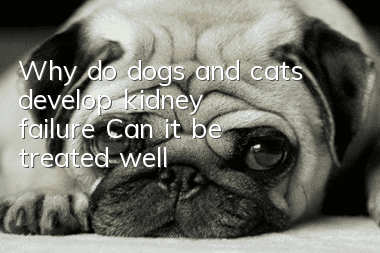Why do dogs and cats develop kidney failure? Can it be treated well?

The status of pets is getting higher and higher. Many people who keep pets are pampered and pampered by their pets. Nowadays, many pets have symptoms of excessive obesity. Pets are kept at home and seldom exercise. Over time, their physical fitness declines and various diseases come to their doorsteps. Of course, illness is also caused by many factors, but if the owner raises the pet scientifically, it will greatly reduce the chance of the pet contracting the disease. Nowadays, kidney failure in dogs and cats has become a very common disease in pets. Many people are frightened when they hear these words and feel that it is very serious. Let’s introduce this condition!
Clinically, kidney diseases in dogs and cats are generally divided into acute kidney injury and chronic kidney disease. Acute kidney injury generally manifests as sudden onset, oliguria or anuria, depression, vomiting and other symptoms; the onset is rapid and the condition is acute. Recovery is possible with prompt treatment. Chronic kidney disease generally manifests as slow onset or transformation from acute kidney injury, polyuria or normal urine output, general mental state, vomiting and other symptoms. Generally, it only occurs when animals have an acute attack (kidney indicators increase sharply) or urine output. Only the owners of abnormal animals will notice it, so chronic kidney disease found clinically is usually in the middle and late stages.
Acute kidney injury (AKI): Some data are still called acute renal failure
The general course of the disease is divided into 4 stages:
The first stage is the initial stage, which occurs immediately when the kidneys are damaged and there are no clinical symptoms at this time.
The second stage is the extension stage. At this time, ischemia, hypoxia, and inflammatory reactions will occur locally in the kidneys and will continue
The cell damage leading to kidney cell apoptosis and necrosis has no clinical symptoms at this time, and it is difficult to detect it through laboratory tests.
The third stage is the maintenance stage, which is characterized by azotemia, uremia, or both occurring simultaneously and may last for several days.
days or weeks. Oliguria or anuria often occurs at this stage, but a few animals also show polyuria or normal urine output during this stage.
The fourth stage is the recovery period. During this period, azotemia or uremia begins to improve, and the renal tubules begin to repair; significant
Polyuria often occurs at this stage, and kidney function may return to normal at this stage, but it is also possible that kidney function will not recover
completely and cause sequelae.
Clinically, non-azotemic renal failure may also occur, and its abnormal characteristics are similar to the polyuria phase in the recovery phase of AKI.
Causes of acute kidney injury (AKI)
|
Common causes of acute kidney injury in dogs and cats |
|
|
Kidney ischemia |
Hypovolemia, hypotension, thrombosis, heart disease, etc. |
|
Infarction |
Thrombosis, etc. |
|
Toxin |
Ethylene glycol, heavy metals, phosphorus compounds, grapes or raisins, hemoglobinuria or myoglobinuria, lilies, venom (snake venom, bees, wasps, etc.), melamine, etc. |
|
Drugs |
Aminoglucosamine antibiotics, amphotericin B, cisplatin, non-steroidal analgesics, imaging agents, etc. |
|
Hypercalcemia |
Rat poison containing vitamin D and other drugs that increase blood calcium |
|
Hyperviscosity |
Hyperglobulinemia, polycythemia |
|
Multiple organ failure |
|
|
sepsis |
|
|
Acute pancreatitis |
|
Infectious diseases, etc. |
Diagnosis:
The main symptoms of acute kidney injury in dogs and cats are abnormal urine output, depression, vomiting, etc. During clinical diagnosis, the diagnosis is usually confirmed through biochemical results, but it should be noted that only when more than 2/3 of the kidney function is damaged, biochemical examination The renal indicators BUN, CREA, and PHOS in the patient will begin to rise; the indicators for early warning examination of kidneys are currently being actively studied, and I believe it will have better indicative significance for early diagnosis of kidneys in the future. In addition to biochemical examinations of sick animals, the following examinations and evaluations should be made before treating sick animals:
1. Assessment of the hydration status of the body: whether there is dehydration or overhydration.
2. Assessment of basic physical indicators: heart rate, pulse, respiration, body temperature, blood pressure, etc.
3. Assessment of cardiovascular status
4. Assessment of kidney size, contour, internal echo, and blood flow conditions
5. Evaluation of other organs in the abdominal cavity: evaluation of other organs such as the pancreas and liver.
6. Whether there is the possibility of poisoning or infectious diseases: heavy metals, organophosphorus, etc., which require special detoxification drugs; or whether there are infectious diseases such as Leptospira.
7. Blood pH and ion balance
8. Urine analysis and bacterial culture
Before treating dogs and cats, it is recommended that the above-mentioned items be carried out in detail. Necessary treatment should be carried out after a full understanding of the animal's physical condition. Acute kidney injury is an acute, severe and dangerous disease. Without a full understanding of the disease, Animals with medical conditions where treatment would be exceptionally dangerous and/or ineffective.
Treatment:
In small animal clinical practice, AKI is defined as the rapid loss of renal unit function, but there is no clear standard definition of the decline in renal function and the staging of injury. In human renal diseases, the latest classification standardsIt has been proposed, but this standard is difficult to apply to small animals because early AKI data such as serum creatinine concentration and urine output are generally unreliable, and it is difficult for doctors to diagnose sick animals after obtaining limited examination reports. There is a very clear judgment on the treatment and prognosis, and the trust between the pet owner and the doctor before treatment is particularly important.
When dogs are sick, their bodies are weak and they need their owners to take care of them and calm them down. When encountering illness, don't shrink back or give up, there will be a turn for the better.
- What should I do if my dog is deficient in calcium? What are the tips for pet parents to supplement calcium for their dogs?
- How to train a German Longhaired Pointer
- What should a novice pay attention to when raising a Teddy? What should a novice pay attention to when raising a Teddy!
- Training and feeding of Alaskan dogs, a must-read for novices!
- Homemade delicious chicken jerky for dogs
- What are the symptoms of allergies in dogs?
- Do all pugs have body odor?
- How should dogs be cared for in autumn? Pay attention to these 3 points when caring for your dog in autumn!
- Before getting a dog, learn how to choose a dog that suits you
- Don’t give these 15 foods to your dog



